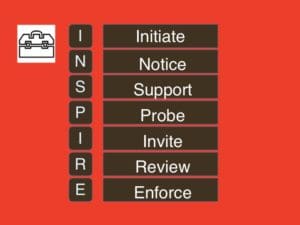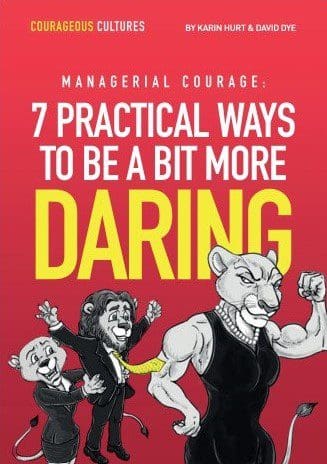How to Deal With an Employee Who Cries At Work
Let’s be real. No one likes to hear what they’re doing wrong, particularly if they know you are right. Giving feedback is tough. Hearing tough feedback is even tougher. What do you do if they cry?
We hear this “What do I do if they cry?” question every time we teach the I.N.S.P.I.R.E. model in our tough conversations training. And we’ve had hundreds of managers confide that they’ve avoided giving needed feedback because the employee is a cryer.
Of course, if you avoid giving feedback because you can’t stand the drama, you’re making the problem worse. The behavior you need to change continues AND you’ve rewarded the crying behavior.
Some emotion is normal, but when someone regularly cries when receiving feedback (or regularly has extreme angry outbursts) it is often a defense mechanism. The unconscious reasoning goes something like this: “If I want my boss to leave me alone, I’ve just got to get a little emotional.”
What To Do if They Cry
We’re going to assume they’re not crying because you’re a jerk–that you’ve delivered the feedback carefully and are coming from a place of genuine concern to help the employee improve.
If your well-intentioned, well-delivered feedback still brings on the tears here are a few tips.
1. Hand them a tissue and wait.
It’s so tempting to keep talking or abort the conversation once the tears start. But here’s the deal: either one of those will limit the other person’s growth. It’s unlikely they’re going to hear anything you’re saying when they’re that worked up. Show some empathy and give them a minute to gather themselves. If they’re still struggling to get their emotions under control, you might suggest regrouping later in the day. Either way, you want to maintain a calm neutral demeanor. Crocodile tears will dry up quickly when you do.
2. Use the I.N.S.P.I.R.E. method to notice the behavior (a quick example)
Learn more about the INSPIRE method and the art of advanced accountability here.
I (Initiate)- “I really care about you and your career and want you to be successful”
N (Notice)- “I’ve Noticed you get emotional whenever we have a feedback discussion.”
S (Support) “For example, in our last one-on-one you cried, and now you’re getting upset again.”
P (Probe) “What’s going on?” (linger here)
I (Invite) “What do you think you could do to be able to engage in these conversations in a more productive way?”
R (Review) “Oh, I think that’s a great idea”
E (Enforce) “So let’s debrief our next feedback conversation next week and talk about how those new strategies went.”
3. Keep your cool
Emotions can be contagious. As a leader, it’s important that you keep the conversation in perspective. You’re giving them feedback because you care and want to help. Their reaction is not about you. Don’t take it personally. Calm, neutral, and curious is your mantra.
4. Check for understanding
When people are in an emotional state it’s more important than ever to ensure they’ve heard you. Once they’ve calmed down ask them to recap what they’ve heard and what they’re committing to do differently (Review), and set up a time to connect again to assess progress (Enforce).
Your turn.
What is your best advice for dealing with a frequent cryer at work?







This article states that tears are a defense mechanism. I disagree. Tears are often an expression of anger – especially for women – who have been socialized against other expressions of rage. Instead of assuming that an emotional response is a manipulative move, let the person tell you themselves what their response means to them.
Thanks for adding to the discussion and the clarification. Yes, as you note, tears serve many purposes (including anger) and are often normal. The quote you mention is with regard to someone who regularly cries when offered any feedback. We would never want a manager to assume that all tears are a defense mechanism. Your suggestion to let the person tell you themselves what their response means is spot on – notice what’s happening and ask them about it.
Hi M, Thanks so much for adding your perspective. I’ve been in a meeting, so just chiming in now.
In addition to what David has shared (which I agree with), I would add that I understand that level of anger that leads to tears and have been there once or twice at work, when something really unjust has happened.
I remember one moment very clearly. We were going through our 4th round of downsizing in 2 years and my boss had just asked me to RIF (downsize) an older woman of color who had done a remarkable turnaround in her performance (after accepting and responding to every single piece of feedback I’d given her.) She’d worked extraordinary hours to turn her performance around and was now one of the highest performers (but we had downsized so much we only had high performers left). She did not have a college degree and I knew at her age, it would be very difficult for her to find another job at the same level.
I got so angry tears began streaming down my face, and my boss just looked at me and said “we just went too far didn’t we?” I nodded yes and asked for a 10 minute break. I then came back and laid out my business case for keeping her. We did. She continued her high-level of performance and actually won an award the following year.
I think in that particular case, my angry tears were a sign to my boss that something was really wrong because it was so out of character for me.
I do understand that everyone’s history and experience is different and pent-up anger and frustration often comes out in ways we would rather it not.
As managers, I do think we serve our teams best when we can make a human connection and help them find more productive ways to express their feelings. If employees are consistently crying at work it does damage their credibility. If we want to serve our employees well, helping them understand and articulate their feelings in other ways is all part of the growth process.
I agree with M Reese in part. My wife is a crier and she’s very aware of it; in fact, hating that she does when she knows it’s not helpful to the conversation. Having had this happen with employees before and learning from my marriage, I have approached it differently: using your INSPIRE model, I might offer the following alternative since all employees are different of course and one thing doesn’t always work for each.
N (Notice) – “Sorry, I didn’t mean to make you upset.”
S (Support) – Offer a tissue, ”Here you go, it’s okay, just take a moment and let me know when we can continue.”
P (Probe) – “This is not at all personal. Do you feel like it is personal and if so…
I (Invite) – “How can I/we keep the focus on performance and help you improve in this area ?”
Mark,
Thanks for the suggestions – the one area I would approach differently is not leading with an apology eg “Sorry, I didn’t mean to make you upset.” As a leader, when you’re sharing feedback that is in the person’s best interest, there is no need to apologize. An alternative might be “it looks like this is upsetting” and then go from there.
I disagree with some of this article. I’m a crier (I hate it but in certain jobs with certain types of managers, I cannot control it). All I ever hear from my manager is negatives when she talks to me; therefore, I end up thinking I can’t do anything right. It’s a self confidence thing. Many of us get our sense of worth from our work (not the greatest thing to do but it IS reality). Hearing feedback, even when it’s constructive, and crying can be a good indicator that the receiver may need some positive reinforcement as well.
Appreciate you adding your perspective! We’re sorry to hear that you only hear criticisms from your manager – that’s not great leadership. Great leaders encourage, coach, challenge, and yes, give performance feedback when it’s needed. We hope leaders who neglect the positive are able to read this article and comments like yours, then reevaluate their effectiveness and focus both on building the relationship and achieving results.
Anon, I too, am so sorry that you’re having that experience with your manager. Have you ever tried to set up time to talk with your manager (not right after she’s given you negative feedback but in a separate meeting?) and talk about what you need? The end of year can be a great time for this. “As I look to 2019, I’m really looking to take my results and relationships to the next level. I wonder if we could schedule a few minutes to talk about what you perceive as my strengths and what I can do to build on them, and also one or two specific areas I can improve?”
Asking for balanced feedback is often a good way to get it.
Also, I wonder if you have a mentor within your organization? A good mentor can be a great sounding board and help you work on your relationship with your boss. Pick someone who is familiar with your work so you have another perspective on the feedback. https://letsgrowleaders.com/2017/07/18/how-do-i-find-a-great-mentor/
Thanks for the follow-up David. I know apologizing can weaken leadership situations and it’s a often a delicate balance. In this regard, I agree we should not apologize for providing important and useful feedback. However, in these cases, I believe apologizing is acknowledging that perhaps the way I communicated may have caused the individual to get upset (without saying that of course). As such, I would be interested in trying different language for the Notice part, but I think that apology/acknowledgement that the individual is upset is important to ensuring effective communication occurs during the remainder of the conversation. This stuff is challenging, like raising kids, there’s a lot of better ways to do things but “the perfect way” is relative to the situation and individual, and thereby often feels just out of reach!
Mark, Ahh yes, you raise a really important point. I have had to apologize many times for giving feedback poorly. Totally agree with that, “I may have not said that as well as I could have. I’m sorry. Let me try again.”
I am so loving this conversation and all of the input and perspectives! Thank you all for expanding the conversation. One aspect of the INSPIRE model we did not flesh out in this particular post is the importance of the first “I” Initiate where you set the stage for the conversation.
We think it’s so important to make a human connection. Something like “I really care about you and your career and I really want you to be successful….” and then “I’ve noticed.”
We have a lot of people coming to view this post so I know it’s a sensitive and important topic. I hope others will continue to add in their perspective as well.
It occurred to me that this related post may be helpful https://letsgrowleaders.com/2018/10/08/7-steps-to-stop-the-drama-a-leaders-ultimate-guide/
Thanks Karin, I like the addition of the Initiate language and appreciate reference to the additional post.
I’m an angry crier, too. I have never had a manager deal with this appropriately, and moreover, they didn’t care to become better managers and would never read an article like this. Most managers don’t hold themselves to the same performance standards they hold employees to. Hence the angry tears. I know this is a quick pithy article to bring attention to your business, but failing to include the anger as a source of tears is wrong. If managers have to give negative feedback, they should look just as deep into reasons management has failed to provide proper support for employees. Nobody wants to do a bad job. If managers are afraid of tears (no matter the source), perhaps they are in the wrong field.
I’m so glad you shared your feelings here as well. Please do know that our mission in the world is to help managers lead better– to achieve great results and show up as a decent human being. Balancing confidence AND humility, results AND relationships.
We are no way advocating for managers to act like jerks. We’re glad the angry tears discussion is coming out in the comments and giving us an opportunity to respond to that.
If employees are crying because of what we call “user” managers focused on results at the expense of relationships we are not advocating for them to continue that behavior. The entire INSPIRE model (and everything we stand for in our training and writing) is about teaching managers to help their employees grow. The INSPIRE Model is designed to be an empowering conversation that taps into the root cause of the behavior and gives the employee an opportunity to share what’s happening and work together on solutions.
If employees find themselves consistently crying something is really wrong. It could be that the manager is not skilled in giving feedback or building the trust needed OR it could be that the employee is really not open to hearing the feedback and is getting defensive OR it could be that there is real scar tissue from previous managers… there are many possibilities. Every situation is different.
What I do know is that after working with managers all around the world we do find that if we can teach the skills to have these tough conversations well and to build trust, it is possible to have productive conversations, even if there are tears. Too many managers are afraid to give feedback to someone who has cried before and so they stop– and nothing gets better.
We all need feedback to learn and grow.
You can see a deeper dive of the INSPIRE Model in this article we wrote here https://hrfloridareview.org/digital/HRFL_1810_Fall/html5forpc.html?page=0
Tears can also be the result of something completely unrelated to work. … spouse, kids, parents. Then they come to work hanging on as best they can not knowing that today’s the day their manager needs to give them a “let’s do things better” talk.
Hi Pammy, thanks for adding your thoughts. We totally agree with you… that is often the case. The INSPIRE model can be very helpful in such cases because it is designed to create a 2 way conversation.
There have been a number of times when the P- Probe phase led to a deeper conversation of underlying issues– and I was so glad that I had asked, “what’s going on?” “how can I help?”
Again, we highly encourage managers to be empathetic and build human relationships with the people on their teams. To care about them and support them. If an employee is constantly crying (a pattern) at work due to issues at home, they may need additional support as well– such as a referral to employee assistance.
I think Pammy makes a great point. I have had to have a few uncomfortable feedback conversations as a manager and at first I handled them completely wrong – at least in the way I basically sprung it on the employee without warning and I wanted to get it over with as quickly as possible. Most of the time they were employees that also happened to have young kids or some personal life issues that I wasn’t aware of and it always led to tears. At the time I was youngish, no kids, no real personal life issues (basically no clue).
I was never disrespectful and I have always liked and cared about people that have worked for me, but I now do two things a bit better. I try to be more aware of cues that someone might be stressed and check-in with them, and in the event that there is a need for coaching I don’t spring it on someone the same day. I set a meeting in the calendar and let them know that I want to review a performance related topic. If it directly relates to a specific issue I will also share the issue ahead of time to allow them to compose their thoughts. So far this has worked well to eliminate tears.
Hi Jim, Yes totally agree with you that setting an appointment is good (that’s part of the I-Initiate). I do think it’s important to give feedback as soon to the behavior happening as possible. And yes, this entire model is designed to help managers prepare for deliberate 2 way conversations that get to root cause,
I read recently that tears that flow from stress (and less face it, feedback is stressful) are different from other tears. They contain cortisol… which means that crying for this reason can be healthy as it flushes the body of chemicals that can compromise health. In addition to the terrific advice in your post, I wonder if leaders might want to challenge their default reaction to crying and try to reframe it. What if we saw tears and thought, ‘great, this person is taking care of him/herself’ and proceeded in that spirit?
Great advice Julie! Tears are nothing to be afraid of and don’t mean you’ve done anything wrong. The empathy and curiosity so many have described are key.
Julie, Thanks so much for expanding the conversation. You raise an interesting perspective which I think can be an important reason to start with the waiting at the beginning as the employee takes a minute to gather their thoughts and compusure.
David and Karin,
Thank you both for responding to all the comments so eloquently and defending both managers and employees in these scenarios. As a manager I have had both employees who cry because something much deeper was going on and the “probe” portion of talking with them was so important to resolving the issues and being able to continue on in a much better manner but I have also had those who cry just to see if it will get a rise out of me. The advice to give people a minute to compose themselves really does filter out those who have things they need to discuss versus those who are trying to get sympathy and out of a situation rather than get empathy and solve the issues. I have been the employee crying and the manager trying to comfort someone crying and neither are comfortable. Thank you for giving out more tools for us who are trying to be better and better managers!
Rebecca, Thank you so very much for sharing your insights and experiences. It’s great to hear that your experiences resonate with this approach. This is clearly a sensitive topic and we are so truly grateful that so many people are offering their insights as we challenge and encourage one another.
We were actually in San Antonio today leading a tough conversations program– and this again resonated as an important (and difficult) topic. I think the more we can talk about this openly the better. That way managers (and employees) know they are not alone.
Rebecca, thanks for sharing your experience here. Your description of giving people a minute to compose themselves acting as a filter is spot on.
You’re welcome – it’s our pleasure. Thank you for your work leading and your desire to be the best leader you can be!
Thank you for this great model. I agree with other commenters that we need to consider the many reasons for tears, and that we don’t know what they’ll be, so remain open. Often, when tears have emerged, I’ve learned they were very shy, lacking in confidence or experience, anticipating being hurt by learning they were doing something “wrong”, or are simply new to re-directing conversations. Having led many people, I can think of exactly none that shed them in anger. Assuming the best of people goes a long way to ease the implementation of the remaining steps in your model.
Jacqueline, Thanks so much! TOTALLY AGREE that assuming the best of people is so vital when implementing this (or any) feedback model. All of our approaches are grounded in our cornerstone Winning Well model (the internal grounding of confidence and humility and the external focus on results and relationships. When you can land in the “and” of all of those, you’ve got a nice running start on getting results that last– while remaining a decent human being.
Jacqueline, thanks for adding these insights. It is easy to get trapped in those assumptions and interpretations. The “probe” step in the INSPIRE model helps us to get beyond our preconceptions, engage in real dialogue, and discover what is really happening.
I’ve had a few INSPIRE conversations with my team, both with cryers and non, and I’d like to say that when I stick to the model, it works. (I haven’t always delivered the feedback well.) By and large my team member improves his or her performance.
I’d like to emphasize the “conversation” piece of the INSPIRE conversation. At each step along the way, I as the feedback giver need to wait until the receiver responds. This is even more necessary when emotions get high. Each element is a conversation, and will move at its own pace, which is not necessarily our pace. When they respond, I check for my understanding of what they said, and when they feel understood (sometimes I ask “Do you feel like I’m understanding you right now?”) then we’re ready to move on.
Peter, So great to see you here! It’s so good to have someone who has been actively working with our INSPIRE model provide input. We’re delighted to hear that it is helpful. Totally agree that the P and the I (where the meaty part of the conversation happens) segments of this model are where the important transformation happens.
Also so glad to hear you are incorporating the check for understanding as well.
Nothing makes us happier than hearing how leaders who have been through our programs are incorporating the techniques into their work with their teams on a regular basis.
Peter, what a great example of how the goal is to both achieve results and build your relationship with your team member. Your suggestion to check in along the way and make sure you’ve checked for understanding and are accurately reflecting what they’re saying is so important.
Thanks for adding to the conversation!
This is a great subject! I would like to add to it. What this whole article feels like is that crying is negative. “What do I do if they cry”, has a negative connotation. Why is that? I get that it causes people to feel uncomfortable but I think as humans we need to take this deeper than just dealing with how to mitigate an uncomfortable situation. Can we get past that and start to get comfortable with it? Crying is human. It is human nature. Why do we constantly make our humanly natural tendencies wrong? We all deal with the positive and negative aspects of our lives on a daily basis. It is my opinion we ought to be crying a lot more than we do. Sometimes we cry to let out the stress that some of these situations cause. So what? We’ve had this natural tendency since we emerged as the human race! There is nothing wrong with it. Isn’t it time we got past avoiding it or assuming the negative about it? If someone cries in my presence due to a discussion we are having, I’m not uncomfortable. I find it exceedingly normal when having a discussion that touches something deep in someone that they would cry. Wonderful! I’m glad you are not keeping it inside and trying to pretend it’s not impacting you! Hiding and suppressing feelings is a dangerous practice. That practice could be the cause of much of the manifestation of disease (diss-ease) in the body. I could go on but suffice to say, couldn’t we start having a conversation of acceptance of the show of emotion rather than making it wrong or presenting tactics to try and stop? Most people just want their feelings acknowledged. Is that so horrible or unacceptable thing to provide as a manager?
Lori, you bring up so many great points. An important distinction is between the normal healthy expression of emotion and someone’s repeated outbursts that play a different role. Totally agree with you regarding the importance of acknowledging and moving through our emotions. Vital for a healthy life.
I came here as a crier, weirdly on receiving both positive feedback and areas for development, for advice on how to control it from the other perspective and I have to say that this ‘model’ would not go down very well with me. Your suggestion for “Support” is not support at all.
I have had a few managers and one who I would strongly consider to be a great leader. I would like to share his means of “dealing with me” for anyone who is interested:
Me: *crying upon hearing positive feedback and areas for development* “Thank you for your patience, I am trying to work on my emotional connection to feedback at work
Manager: Please do not apologise for your response, your passion and emotion is often what sets you apart. However, if you are happy to continue I would like to focus for a second on your emotional connection to success and failure. Do you have any ideas on how we can work on this?
Me: *through some sniffs and snorts* “I just don’t know why it happens but perhaps I could benefit from some form of coaching or mentoring?”
Manager: Yes I think so too, I have just the person in mind…
Crying is NOT a weakness. I tell my 5 year old boy when he cries and thinks he “should be brave” that often crying is in fact the bravest thing that someone can do. Crying in every feedback session is not great though, and my manager dealt with this in such a great way.
SB, Thank you so much for your transparency and sharing your very valuable insights. It sounds like you have a compassionate manager who cares deeply about you. I love that! The other thing that I would add is that some of the very best team members on my teams were the ones that got emotional from time to time. It was because they cared so deeply.